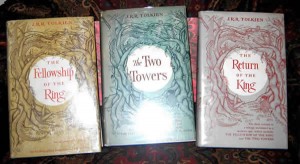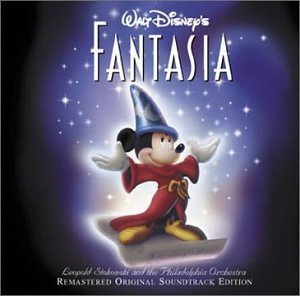Dances for Tolkien
Theme Songs Page | Previous Theme Song | Next Theme Song
Dances for Tolkien
Polovetsian Dances by Alexander Borodin (with Nikolai Rimsky-Korsakov and Alexander Glazunov) (1890)
The Sorceror’s Apprentice by Paul Dukas (1897)
Encountered 1961?
I come now to a record, indeed a kind of record, that seems to have disappeared, even from the electronic yard sale racks of E-Bay. Heaven only knows where my own copy disappeared to, probably four decades ago. I’m speaking of my grocery store classical music anthology.
Many people can remember grocery store encyclopedias, sold a volume a week.[1] This was the same idea, but instead of volumes, the grocery store would sell classical records. Along with the first one, you got a leatherette binder about four inches thick, all in burgundy with black accents and gold lettering, with a title something like The Treasury of the World’s Great Music. Whatever the title was exactly, I know it suggested that once you bought and learned about all the pieces inside, you’d be a connoisseur. Well, I wanted to be that, so I persuaded my mom to pop for a dollar or so at the A&P on Huron Street each time one more piece of vinyl sophistication was issued.
As I’ve said before, my parents were out to make an intellectual, so they took little persuading. They had their own quite extensive collection of classical music, but if I wanted a set for myself, they’d see to it that I got one.
The arrival of each LP was an event. Each record came in a sleeve punched to fit in the binder. Accompanying it was a lavishly-illustrated (in black ink plus one extra color) leaflet, I think of eight pages, that told you all about the pieces on the record, and the life of the composer. I’d crack open the cellophane package, unscrew the binder, insert my leaflet and liner, rescrew it, and get right to work listening and reading.
And this was what brought Beethoven and Bach and Berlioz and Grieg and Tchaikovsky and a host of others into my life. I learned of Beethoven’s deafness, and what his symphonies sounded like (I think they packaged two of them). I learned that something had been dreadfully wrong with Tchaikovsky’s marriage (though not precisely what) and how he had been rescued by the kindly benefactress Mme. Von Meck, and I came to recognize the sound of the Pathétique. And incidentally, I came across the perfect theme music to accompany one of my most gripping literary experiences.
I wish I could tell you exactly when my parents introduced me to J.R.R. Tolkien. I’m pretty certain it was sort of an afterthought after I’d kind of exhausted C.S. Lewis’ Narnia series. I had literally grown up with the Narnia books; Lewis had started to publish them in 1950, and my mother and I were living in London then, and she bought them for me hot off the press. I still have The Lion, The Witch and the Wardrobe and Prince Caspian in their British hardback editions, much the worse for wear. By 1956, though, Lewis had finished his seventh and last Narnia book.[2] Somewhere my parents heard about Tolkien, how he was somewhat the same kind of thing.
And so, kind of as an experiment, I think, they got me the first Houghton Mifflin edition hardback Tolkien.

That took – boy, did it take! So they bought me the second, and then the third. Again, I still have these, though unfortunately the dust jackets are long gone. I read them over and over. I copied runes, and actually tried to send people messages in runes. And of course I was making a movie in my head, though I had no idea how it could possibly be done.[3]
I have a memory of reading The Lord of the Rings in my bed early in the morning. There was a second-floor window close to the head of my bed, and there was a mulberry tree below it on which birds liked to perch and sing. In summer the windows would be open (no air conditioning). So naturally I’d be up early. It was a wonderful, quiet time. And there I would sit with various books.
I could riff on some of the other books, but my point is that I very specifically recall the thrill of reading Tolkien sitting there. And while I was reading it, I often had playing softly, so as not to wake my parents (on my grey two-tone Columbia record player) one particular record from The Treasury of the World’s Great Music. This LP combined on one side the symphonic version of Borodin’s Polovetsian Dances and Dukas’ The Sorceror’s Apprentice. Now with all respect to Howard Shore’s estimable soundtrack for the Peter Jackson’s near-definitive movies, once you’ve listened to these pieces, you will never think of Shore as being in the same class in capturing the thrill of those books.
Yes, I know that these pieces were written to capture something rather different. Borodin (together with his posthumous collaborators Mussorgsky and Glazunov), was seeking to convey the exoticism of the Central Asian Polovtsi people, who are not Russian like the audience, and not the good guys. Paul Dukas was setting an ancient cautionary tale in a dark but humorous scherzo. And probably I would never have associated these things with Tolkien if I’d seen them in their more accustomed settings, the grand opera for Borodin (see a video here), and Fantasia for Dukas (see the complete video here). I was at least on notice with the Dukas, as there was in my booklet a still of Mickey Mouse as the Sorceror’s Apprentice from the 1940 movie. But it made little impression.
If you can listen to these pieces without that baggage, though, you can see what wonderful accompaniments they make to Tolkien’s epic. You think about what’s in those books and, as they say, there’s an app for that.
Much of the books is about traveling, mostly to unfamiliar, desolate places. Listen to the opening notes of the Introduction to the Dances, and see if you don’t agree this is perfect. This is the theme that got made into the song Stranger in Paradise in the musical Kismet. It combines wonder with just the right subdued quality to mirror the emotions of the Fellowship as they would cross downs and tramp through forests. The same theme turns up in the fifth movement, the Moderato alla breve, and there there’s so much filigree and ornamentation jumping mischievously around, you could envision the younger hobbits doing foolish things while on the road.
And when you get to the second movement, the Allegro Vivo, it will conjure up troops of horsemen, the Rohirrim, let us say.
Movement three, the Allegro: at least intermittently a battle scene. It would work with the big fight outside Minas Tirith, for instance.
Movement four, the Presto: a fight or a flight by night, such as might have happened at the Inn at Bree, or Weathertop. This theme returns in the sixth movement, also a Presto.
The final movement, Allegro con spiritu, known to Kismet fans as Not Since Nineveh, conjures up a busy town like Minas Tirith.
Now, although there are certainly dark notes in Polovetsian Dances, they don’t begin to compare with the darkness in Sorceror’s Apprentice. There’s definitely a wintry kind of joviality there too, obviously, but this is programmatic music, and the story it tells is set in a sorceror’s den. Which is the ideal place to begin a setting of Tolkien; the Ring, after all, starts in exactly such a place. There are other dark places in the story, lots of them, Mirkwood, and Weathertop by night, and the mines of Moria, and the Paths of the Dead, and Shelob’s Lair, and Mordor itself. And Dukas’ brooding tones are perfect for this.
The apprentice is a Pippin type, getting in trouble through bumptious overconfidence. The capriccioso themes that depict him work perfectly for that.
And then there is music depicting something magic gone completely out of control – which is really what Tolkien’s whole story is all about. It gets more and more tumultuous and scary, until it stops. Just like Tolkien.
Obviously the books are long and the pieces are short, less than 20 minutes total, which is why they fit nicely on a single side of an LP. And obviously I was listening to lots of other things over the several readings I gave those books. But there was never any question what record of mine gave the most scope to my musing how to make – and score – a movie based on them.
[1]. In fact, I’ve recently seen a 2008 blog post that suggests these are still available somewhere.
[2]. I believe, although I cannot substantiate this with Web research, that the American editions came out somewhat later. I think, for instance, I was given the last one, The Last Battle, shortly after its American publication. And I certainly was older than seven, which is the age I turned in 1956, the date of its British publication.
[3]. Peter Jackson, who actually directed the epic film trilogy, and who must have been born just about exactly the time I was discovering Tolkien (Halloween 1961 was his birthdate), would have to await digital technology just like everyone else.
Copyright (C) Jack L. B. Gohn, except for album and book artwork
